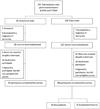Telemedicine: The New "Virtual Reality" of Female Pelvic Medicine and Reconstructive Surgery?
- PMID: 35272338
- PMCID: PMC8919843
- DOI: 10.1097/SPV.0000000000001149
Telemedicine: The New "Virtual Reality" of Female Pelvic Medicine and Reconstructive Surgery?
Abstract
Importance: Understanding women's acceptance of telemedicine as a model of care for pelvic floor disorders (PFDs) allows for a more patient-centered approach to widespread implementation in female pelvic medicine and reconstructive surgery.
Objectives: The pandemic sparked rapid and widespread implementation of telemedicine. Our goal was to assess acceptance, satisfaction, and desire for future use of telemedicine among women seeking care for PFDs.
Study design: We performed a structured telephone survey of new patients who underwent video visits, and established patients who underwent video or telephone visits, when nonurgent, in-person visits were suspended. Our survey assessed the following domains: satisfaction, future use of telemedicine, level of comfort, perceived utility, and access and comfort with technology.
Results: Between April and July 2020, we conducted telemedicine visits with 221 patients, 131 (63% of eligible patients) of whom agreed to participate in our survey (63 (74%) telephone and 68 (56%) video, including 35 established and 33 new patients). Overall, most participants (96.3%) described being "very" or "somewhat satisfied" with telemedicine in addressing their needs and "comfortable" sharing personal information with providers in a telemedicine visit (94.7%). However, video participants (both new and established) were more likely to view telemedicine as valuable (P = 0.02) than telephone participants. Furthermore, established video participants perceived greater quality care of care (P = 0.01) than telephone participants.
Conclusions: Video telemedicine is a well-accepted adjunct model of care with the potential to expand the reach of quality subspecialty care of value to women with PFDs.
Copyright © 2022 American Urogynecologic Society. All rights reserved.
Conflict of interest statement
H.M. was funded by grant T32 DK120497-01A1. The remaining authors have declared they have no conflicts of interest.
Figures
References
-
- Services CfMaM. Telemedicine https://www.medicaid.gov/medicaid/benefits/telemedicine/index.html
-
- Nesbitt Thomas MD, M.P.H. The evolution of Teleheath: Where Have We Been and Where Are We Going?. National Academies Press (US), Washington (DC) 2012.
-
- Intelligence M. Global telemedicine market: growth, trends and forecasts (2015-2019). 2015.
Publication types
MeSH terms
Grants and funding
LinkOut - more resources
Full Text Sources
Medical
Miscellaneous


